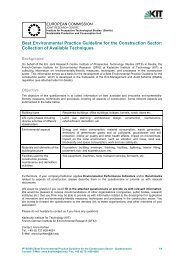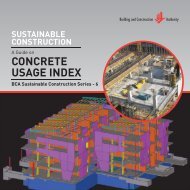Waste reduction final report -4 - Test Input
Waste reduction final report -4 - Test Input
Waste reduction final report -4 - Test Input
Create successful ePaper yourself
Turn your PDF publications into a flip-book with our unique Google optimized e-Paper software.
Table 3: Construction waste material types and amounts in civil engineering [FOEN 2008c].<br />
Material MT Percent<br />
Gravel/Sand 5.17 60%<br />
Asphalt 2.33 26%<br />
Concrete 0.99 11%<br />
Bricking 0.17 2%<br />
Mineral remaining fraction 0.08 1%<br />
Total 8.74 100%<br />
Recycling methods are well known and well-proven for these materials and widely accepted.<br />
The total volume of waste is not supposed to rise much in the future (see chapter 0).<br />
Furthermore, [Brunner, et al. 2006] estimates a constant demolition rate of about 0.3%<br />
between 1990 and 2050. Other materials in civil engineering not considered here are e.g.<br />
steel, polyethylene, or other plastics.<br />
After we have seen that many different waste types arise, chapter 0 will present ways of<br />
disposal and recycling commonly used in Switzerland.<br />
Disposal methods<br />
In the past, the majority of mineral demolition material was disposed of in landfills and<br />
therefore consider the life cycle. Primary resources, especially gravel, were strained more and<br />
more with rising building activities and new ways of waste treatment were established. Figure<br />
10 shows the different disposal routes of construction waste in 1997 with an estimated total<br />
of 11.1 MT of construction waste (see also p. 23).<br />
Figure 10: Disposal routes of construction waste 1997 [FOEN 2001].<br />
Most of the waste is directly used on the construction site – this is mainly possible in civil<br />
engineering. Indirect use can be recycling or another appropriate treatment and use. The<br />
percentage of landfilled material is still quite high, but should be reducing due to new<br />
regulations and efforts for reuse of materials. Incineration takes mainly place for wood. For<br />
civil engineering, some more detailed data was available on Table 4.<br />
96
















